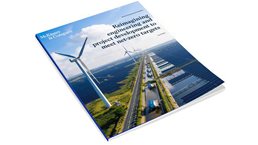For the industrial economy to meet net-zero emissions by 2050, capital spending over the next three decades would need to increase from the $5.7 trillion spent annually today to $9.2 trillion spent annually—an estimated increase of $105 trillion overall.1 Such a massive reallocation of capital would likely trigger a period of rapid innovation and growth, reshaping entire industries and revolutionizing the ways businesses create value across industries. High-emitting industries such as oil and gas, power, and manufacturing will need to leverage emerging technologies to create new energy and infrastructure systems at scale while reducing project life cycles.
Looking to the future, success will depend on how quickly today’s industries transition to green energy by phasing out carbon-intensive operations. The International Energy Agency and McKinsey have separately estimated that more than 50 percent of the volume of carbon that needs to be cut over the next decade will come from decarbonizing industrial and energy systems. Implementing strategies to move to green energy will require companies to deploy technologies to help decarbonize industrial processes. As an example, a rapid increase in government and industry pledges for clean-fuel production has resulted in a market for biofuels that can replace jet fuel.

Voices on Infrastructure: Reimagining engineering and project development to meet net-zero targets
Many opportunities in the shift to green energy involve electricity. Thus, the greatest risks and opportunities today may lie in the industries that remain difficult to electrify, such as air transport, heavy mining, oil refining, and the production of steel and cement. Some of the most interesting opportunities in these sectors involve carbon capture, utilization, and storage (CCUS) technologies, as well as technologies for shifting from fossil fuels to hydrogen.
The risks from these new technologies, combined with capital requirements and the sheer scale of engineering and construction needed, will require new operating models and sets of engineering capabilities for the entire industry. Our April 2022 edition explores how companies on the cutting edge of engineering and project development are navigating the transition. We talked with Shaun Kenny, president of Bechtel’s infrastructure global business unit, and Aleida Rios, senior vice president of engineering at BP, about how to increase the pace of developing energy and infrastructure projects.

